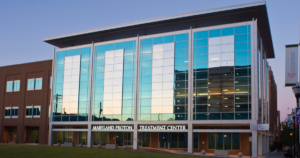American Cancer Society Studies Show Increase in Proton Beam Therapy But Racial Disparities; Maryland Proton Treatment Center Proactively Addresses Health Equity
May 5, 2022
April 28, 2022
Two new studies led by American Cancer Society (ACS) researchers show an increase in the use of proton beam therapy (PBT) for patients with cancer in the US during the past decade. Of nearly six million patients analyzed, the use of PBT increased overall for newly diagnosed cancers from 0.4% in 2004 to 1.2% in 2018. However, Black patients were less likely to receive PBT than white patients, and this racial disparity increased over time. The studies were recently published in JAMA Network Open.
“We found that PBT use increased nationally between 2004 and 2018 for all eligible cancers, especially for cancers for which PBT is the recommended radiation treatment,” said Dr. Leticia Nogueira, senior principal scientist, health services research at ACS and lead author of both studies. “Especially concerning; however, was our findings also showed racial disparities increased as availability of PBT increased in the U.S.”
The Maryland Proton Treatment Center (MPTC), the only treatment center of its kind in Maryland, attracts and treats a diverse population of patients from all over the region thanks to its affiliation with the University of Maryland Marlene and Stewart Greenebaum Comprehensive Cancer Center, a large array of 30 clinical trials and patient focused support initiatives. From January 2018-November 2020, over 2,300 cancer patients have received proton therapy at MPTC. Compared to the results of the ACS studies, MPTC treats a higher proportion of minority patients with approximately 40% of patients during this time period being minority and 23% Black. This is significantly higher than the national average.
“Further analysis of this patient population led us to find that many of our patient focused support initiatives contribute to this high rate of receipt of treatment for this population,” remarked Dr. Elizabeth Nichols, Associate Professor of Radiation Oncology at the University of Maryland School of Medicine and the Vice Chair of Clinical Affairs. One such initiative amongst others like partnering with the ACS is transportation services for qualified, established patients which allows many patients who do not have means to receive treatment at MPTC. Support services for cancer patients have been impacted dramatically during the COVID-19 pandemic. “Our study showed that while access to proton therapy is impacted by race and socio-economic status, mitigation of transportation needs can significantly improve access to care for key patient populations,” stated Dr. Nichols.
The center’s location in West Baltimore at the University of Maryland Bio Park, as well as its proximity to the American Cancer Society’s Hope Lodge where cancer patients who travel can stay for free, have also played a role in decreasing barriers to care.
PBT is a form of radiation treatment used to destroy tumor cells. Instead of using traditional photon-based radiation treatment, it uses protons to send beams of high energy that can more precisely target tumors and decrease damage to surrounding healthy tissue. PBT is potentially superior to photon-based radiation therapy for tumors with complex anatomy, tumors surrounded by sensitive tissues, and childhood cancers. PBT can be double the cost of traditional photon-based radiation therapy, but this is not the case at MPTC where they have instituted a cost neutral model for their proton therapy in comparison to photon treatment.
Private health insurance was the most common insurance type among patients for which PBT was the recommended radiation treatment, while Medicare was the most common insurance type among patients treated with PBT for cancers for which its efficacy is still under investigation. MPTC has a 90% insurance approval rating inclusive of Medicare, Medicaid, private insurances, and other payors which could also be a factor in its patient diversity.
Researchers also found Black patients were less likely to be treated with PBT than White patients (0.3% vs. 0.5%), especially for cancers for which PBT is recommended over photon-based radiation therapy. Importantly, the racial disparity in receipt of PBT increased as the number of facilities offering PBT in the US increased, and this disparity was not eliminated after additional matching on socio-economic status or health insurance coverage type.
“Our findings, unfortunately, highlight the fact that Black patients continue to benefit less from advances in medicine like PBT, even with increased availability of recommended treatment modalities,” added Dr. Nogueira. “Efforts other than increasing the number of facilities that provide PBT will be needed to eliminate these disparities.”
“We are hopeful that these studies as well as our research will continue to highlight the importance of access to care for vulnerable patient populations. Many of the interventions we have performed at our center can be easily adopted and implemented at other proton centers and/or centers with advanced cancer therapies,” said Dr. Nichols.
For both studies, researchers used the National Cancer Database, a hospital-based cancer registry jointly sponsored by the American College of Surgeons and the ACS. This database includes over 1,500 facilities accredited by the Commission on Cancer and collects treatment information on over 70% of individuals diagnosed with cancer in the U.S. To evaluate patterns of PBT, data was analyzed using the American Society for Radiation Oncology (ASTRO) policies – which lists cancers for which PBT is the recommended treatment modality and cancers for which PBT is still being evaluated.
Resources from the American Cancer Society to address racial disparities in cancer care can be found at www.cancer.org/healthequity.
About the American Cancer Society: The American Cancer Society is on a mission to free the world from cancer. We invest in lifesaving research, provide 24/7 information and support, and work to ensure that individuals in every community have access to cancer prevention, detection, and treatment. For more information, visit cancer.org.



